Worcestershire
Explore hidden histories, historic photos, and things you never knew about Worcestershire from the collections and archives of Historic England.
Discover your local listed buildings and places
Introducing some of Worcestershire's most historic sites, included in the National Heritage List for England. Some of these captions have been summarised by AI. Click through for the official List entry. Skip this section and go to place by numbers
Powick Old Bridge
Powick
Powick Old Bridge 520m north of Cromwells Tavern. Read the official list entry to find out more.
The Fleece Inn
Bretforton
Farmhouse of probable mid-C15 origins, extended and remodelled in the C17 and licensed as a public house from 1848. Read the official list entry to find out more.
Powick Old Bridge (That Part Within the City of Worcester)
Worcester
Powick Old Bridge, spanning the River Teme, saw crucial English Civil War battles in 1642 and 1651. This 16th-century structure was partly destroyed and later restored.
Rous Lench Court
Rous Lench
Rous Lench Court, a historic manor, associated with John Rous and visited by Cromwell, features topiary gardens, a timber-framed manor house, and a C19 landscape park.
Westwood Park
Doverdale
Westwood Park features 17th-century gardens, extensive C18-20 modifications, and a significant historical hunting lodge evolved into a residence, now a Grade I listed building.
Monument to Jenny Lind in Great Malvern Cemetery
Malvern
Monument by Charles Bell Birch to opera singer Jenny Lind, installed following her death in 1887 and altered following the death of her husband, Otto Goldschmidt, in 1907.
Church of St Kenelm
Romsley
A parish church incorporating 12th to 15th-century architecture, believed to be linked to St Kenelm's legend, featuring a notable tympanum and a distinct timber-framed porch.
61, Broad Street
Worcester
61 Broad Street, also known as Cupola House, is a historic building featuring 18th-century architecture with a rich history of notable residents and commercial usage.
Sports Hall (formerly Edinburgh Sports Dome)
Malvern
The Sports Hall was built in 1977 for Malvern Girls College by Michael Godwin (architect) with John Faber of Oscar Faber as engineer and NorWest Holst Construction as advisers.
Church of St James
Birlingham
Parish church with C15 tower, but the remainder by Benjamin Ferrey, 1871-72. Read the official list entry to find out more.
Croome Court
Croome D'abitot
A mid-C18 landscape park by Lancelot Brown, his first independent commission associated with a country house; features include parkland buildings of the highest quality by Brown, Robert...
Pershore Bridge
Pershore
Pershore Bridge, a Grade II* listed multi-span bridge from the 15th century, was constructed by Pershore Abbey monks and features significant medieval architecture.
Ham Bridge
Clifton upon Teme
Ham Bridge, a multi-span structure from the medieval period, retains significant architectural features despite modifications. It was originally built by the Mortimers.
Great Malvern Station
Malvern
Station buildings for the Worcester and Hereford Railway of 1861-62 designed by Edmund Wallace Elmslie with sculpture and metalwork by William Forsyth.
Retaining Wall with Sculptural Relief by William Mitchell…
Kidderminster
A 320m long sculptural concrete retaining wall, built between 1972 and 1973, designed by J G Stewart in collaboration with Douglas H Smith, with decorative surface relief designed by William...
Debdale Lock and Associated Weir, and Cave
Wolverley and Cookley
Lock, circular weir and cave at Debdale forming part of the Staffordshire and Worcestershire Canal,which opened to traffic in 1772 and was designed by James Brindley (1716-72).
Battle of Worcester 1651 with Powick Old Bridge 1642
Powick
The Battle of Worcester in 1651 marked the end of the English Civil Wars, with Cromwell defeating Charles II's forces. Key sites include the Civil War Museum and Powick Old Bridge.
Spetchley Park
Spetchley
Spetchley Park, an estate purchased by Rowland Berkeley in 1606, features significant 19th-century gardens and landscapes influenced by Rose and Ellen Willmott.
Hewell Grange
Tutnall and Cobley
A former country house, now an open prison, built 1884-1891 for Lord and Lady Windsor, later the Earl and Countess of Plymouth, to designs by Thomas Garner of Bodley and Garner.
Battenhall Mount (former St Mary's Convent School)
Worcester
A large suburban house of c.1867 built for William Spriggs, which was considerably extended in the 1890s for the Hon.
Great Malvern Station covered pedestrian walkway and good…
Malvern
Two tunnels, dating from c.1863 and perhaps designed by EW Elmslie, forming a pedestrian approach and a goods entrance to the former Great Malvern Hotel (now Malvern St James' School).
Nos. 31-35 (odd) High Street, Droitwich
Droitwich Spa
A medieval hall house, now divided into three premises. The building dates from the period around 1400 and has C17, C18, C19 and C20 additions and alterations.
Huddington Court
Huddington
Huddington Court is a 16th-century timber-framed house, associated with the Catholic Wintour family and the Gunpowder Plot.
The Parish Church of St Mary and All Saints
Kidderminster
The Parish Church of St Mary and All Saints features a Perpendicular tower, restored by Sir Giles Scott, alongside noteworthy 15th-century Beauchamp and Cokesey tombs.
Midland Railway Goods Shed and associated weighbridge
Worcester
Goods shed and offices, 1867-1868, designed by the Midland Railway architect's department, led by John Holloway Sanders. Read the official list entry to find out more.
Guildhall
Worcester
Guildhall in Worcester, built circa 1721-3, is a grand civic building noted for its elaborate iconography and historical significance in the development of public building planning.
Hewell Grange
Bentley Pauncefoot
A landscape park developed from the mid-C18 with advice from William Shenstone and Lancelot 'Capability' Brown, redesigned in 1812 by Humphry Repton with later alterations of the late C19...
Arley House
Upper Arley
Arley House, on the River Severn, boasts a 19th-century arboretum and gardens redeveloped since 1965, alongside significant historical connections to the Lyttelton and Annesley families.
Abberley Hall
Abberley
Abberley Hall, rebuilt after a fire in 1845, is a 19th-century Italianate-style mansion known for its prominent Gothic stone clock tower and extensive Victorian pleasure gardens.
The Council House (Malvern Hills District Council Offices)
Malvern
A house, built 1874-80 for Albert Miles Speer by Henry Haddon, with carving by William Forsyth and stained glass by Heaton, Butler and Bayne, used as a preparatory school between 1909 and...
Witley Court
Great Witley
Witley Court is a notable landscape park with 19th-century gardens by W.A. Nesfield, associated with a Victorian-era house known for its grandeur before a 1937 fire.
Church of St John the Baptist
Worcester
The Church of St John the Baptist, originating in the 12th century, showcases notable architectural evolution and houses significant memorials, including effigies and cartouches from the...
Severn Bridge including Flanking Arches and Balustrade
Bewdley
A bridge across the River Severn by Thomas Telford, constructed in 1797-1799 using sandstone with flanking arches and iron and stone balustrades.
The Old Palace
Worcester
The Old Palace, a historically significant building in Worcester, has origins dating back to the early 13th century. It has hosted royal visits from Elizabeth I and George III.
Cathedral Church of Christ and St Mary
Worcester
Summary of the Cathedral Church of Christ and St Mary captures its rich historical evolution, architecture featuring contributions from medieval designers, and significance in Worcester's...
Huntingdon Hall
Worcester
Built in 1804 and restored in 1987, Huntingdon Hall functioned as a chapel and now serves as a concert hall, reflecting distinct historical and architectural value.
Madresfield Court
Guarlford
Madresfield Court is linked historically to the Lygon family since the 15th century and inspired aspects of Evelyn Waugh's "Brideshead Revisited." It features distinctive 19th-century...
Roman Catholic Church of Our Lady and St Alphonsus with a…
Hanley Castle
A Roman Catholic church of 1846, designed by Charles Hansom with internal fittings by Augustus Welby Northmore Pugin. Read the official list entry to find out more.
Explore more
Search for more listed placesWorcestershire through time
This timeline shows the first period of use for buildings and places on the National Heritage List for England, just one of the details recorded for every list entry. Click around to see how Worcestershire changes over time. Skip this section and go to aerial photos
Prehistoric Before AD 43
Prehistory covers a million years of human occupation before the Roman invasion and the introduction of writing. Primarily hunter-gatherers of several human species including Neanderthals, the peoples moved across Europe, hunting animals, exchanging ideas and developing complex culture and belief systems including burial rites and astronomical understanding, as at Stonehenge for example.
Roman AD 43 to AD 410
Britain was invaded by four legions of the Roman army in AD 43, who relatively rapidly conquered England from landing points in Kent. Parts of Wales and Scotland soon followed.
Roman culture brought urbanism, monumental buildings, wide-ranging religious beliefs, writing, and strong social hierarchy. The Roman administrative system was withdrawn in AD 410.
Early medieval AD 410 to AD 1066
This period, often associated in England with Anglo-Saxons and Vikings, saw a reduction in urban living from the Roman period and increased migration from northern Europe.
Traces of this period can be found in cemeteries, particularly in artefacts and in some of the very early churches, as this period also saw the growth of Christianity in Britain.
Medieval AD 1066 to AD 1540
This period, sometimes known as the Middle Ages, began with the Norman invasion in AD 1066. It saw a significant rise in military and defensive buildings such as castles and earthworks, as well as religious houses dominating a largely agricultural landscape.
The monarchy and Church dominated the period, which also saw the break with the Roman Catholic Church and the English reformation.
Post medieval AD 1540 to AD 1901
The Post-Medieval period brought seismic changes to life in England, with religious reformation leading to the democratization of worship and the destruction of hundreds of religious houses.
In parallel, there was a huge expansion of scientific study and enlightenment that permanently altered the nation's social structure and landscape. Industrialization and mass production lead to wider global trade, emigration, and immigration.
20th century AD 1901 to AD 2000
The 20th century saw an incredible expansion of England's transport networks, with suburban growth shadowing rapid infrastructural expansion. The establishment of state schools, hospitals, and modern technical colleges, with new architectural styles, radically changed the appearance of towns and cities.
Two catastrophic world wars and the 1918 pandemic also brought unprecedented change, altering England's built environment and social structures forever.
Prehistoric Before AD 43
Prehistory covers a million years of human occupation before the Roman invasion and the introduction of writing. Primarily hunter-gatherers of several human species including Neanderthals, the peoples moved across Europe, hunting animals, exchanging ideas and developing complex culture and belief systems including burial rites and astronomical understanding, as at Stonehenge for example.
Roman AD 43 to AD 410
Britain was invaded by four legions of the Roman army in AD 43, who relatively rapidly conquered England from landing points in Kent. Parts of Wales and Scotland soon followed.
Roman culture brought urbanism, monumental buildings, wide-ranging religious beliefs, writing, and strong social hierarchy. The Roman administrative system was withdrawn in AD 410.
Early medieval AD 410 to AD 1066
This period, often associated in England with Anglo-Saxons and Vikings, saw a reduction in urban living from the Roman period and increased migration from northern Europe.
Traces of this period can be found in cemeteries, particularly in artefacts and in some of the very early churches, as this period also saw the growth of Christianity in Britain.
Medieval AD 1066 to AD 1540
This period, sometimes known as the Middle Ages, began with the Norman invasion in AD 1066. It saw a significant rise in military and defensive buildings such as castles and earthworks, as well as religious houses dominating a largely agricultural landscape.
The monarchy and Church dominated the period, which also saw the break with the Roman Catholic Church and the English reformation.
Post medieval AD 1540 to AD 1901
The Post-Medieval period brought seismic changes to life in England, with religious reformation leading to the democratization of worship and the destruction of hundreds of religious houses.
In parallel, there was a huge expansion of scientific study and enlightenment that permanently altered the nation's social structure and landscape. Industrialization and mass production lead to wider global trade, emigration, and immigration.
20th century AD 1901 to AD 2000
The 20th century saw an incredible expansion of England's transport networks, with suburban growth shadowing rapid infrastructural expansion. The establishment of state schools, hospitals, and modern technical colleges, with new architectural styles, radically changed the appearance of towns and cities.
Two catastrophic world wars and the 1918 pandemic also brought unprecedented change, altering England's built environment and social structures forever.
Aerial photos of Worcestershire
Aerial photography helps reveal secrets of England's changing landscapes that are impossible to see from the ground. Skip this section and go to archive images

Hunnington
The Blue Bird Toffee Factory on Bromsgrove Road, Hunnington, 1936
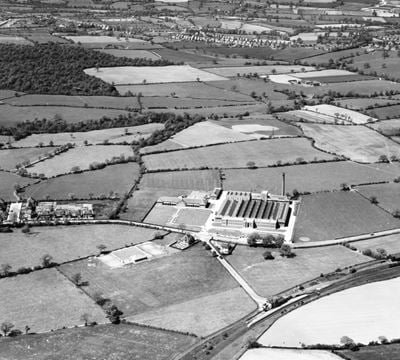
Hunnington
The Blue Bird Toffee Works and the surrounding countryside, Hunnington, 1948
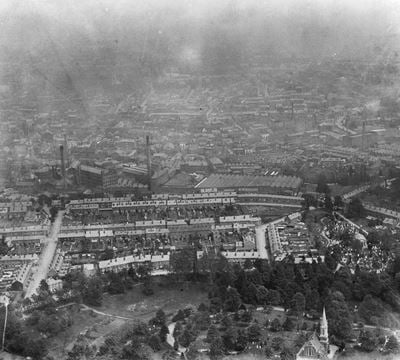
Kidderminster
Carpet works and Slingfield Spinning Mill, Kidderminster, 1920
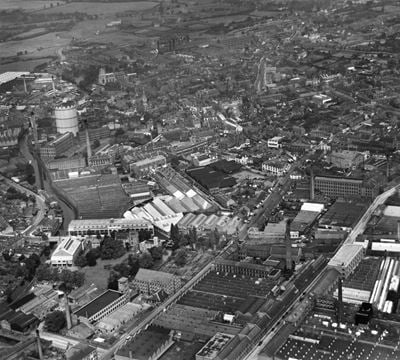
Kidderminster
New Road and the town, Kidderminster, 1938
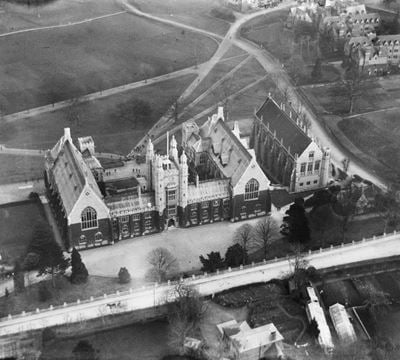
Great Malvern
Malvern College, Great Malvern, 1920
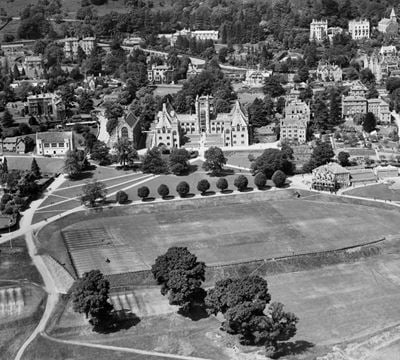
Great Malvern
Malvern College, Great Malvern, 1933
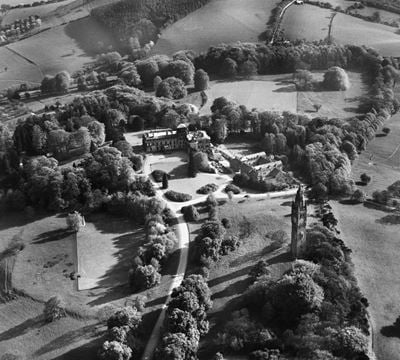
Abberley
Abberley Hall School and the Clock Tower, Abberley, 1934

Abberley
Abberley Hall School, the Clock Tower and environs, Abberley, 1934
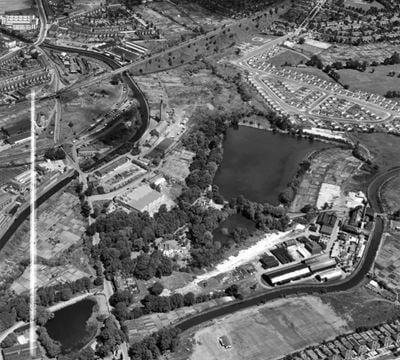
King'S Norton
Lifford Chemical Works, Lifford Reservoir and environs, King's Norton, 1951
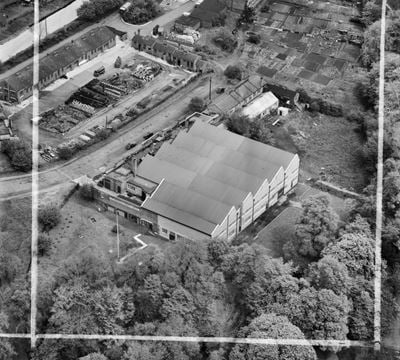
Lifford
The Worcester Brass Co Ltd Works on Ebury Road, Lifford, 1952
Worcestershire in the Historic England Archive
The Historic England Archive cares for over 15 million images, dating from the 1850s to the present day. Discover stunning images of Worcestershire's past. Skip this section and go to stories about heritage
Charles George Harper Collection
Wychavon, Worcestershire
Date created: 1892 - 1933
The entrance doorway to the Lygon Arms Hotel
Eric de Mare
Bromsgrove, Worcestershire
Date created: 1945 - 1980
Interior view of the Pumping Station in Tutnall and Cobley looking up towards the roof trusses.
John Gay Collection: Counties
Wychavon, Worcestershire
Date created: 1958
View through long grass towards the east end of St. Mary's Church, Elmley Castle
London, Midland and Scottish Railway Company
Wychavon, Worcestershire
Date created: 1931 - 1933
A view of Abbot Reginald's Gateway taken from the south, showing part of the timber-framed chamber above
Nigel Temple Collection of Postcards of Parks and Gardens
Wychavon, Worcestershire
Date created: 1900 - 1940
EXTERIOR VIEW OF THE PRIORS MANSE TEA HOUSE
Walter Scott
Wychavon, Worcestershire
Date created: 1925 - 1950
A general view looking down Church Street towards St Michael's Church, Broadway
Charles George Harper Collection
Malvern Hills, Worcestershire
Date created: 1880 - 1900
A view from the south-west of the Village Cross and Stocks
Eric de Mare
Impney Park, Wychavon, Worcestershire
Date created: 1945 - 1980
Exterior view of Chateau Impney with garden ornaments in the foreground.
John Gay Collection: Counties
Wychavon, Worcestershire
Date created: 1950s
A woman bending over by the porch of Church Cottage, with Japanese anemones in the foreground.
London, Midland and Scottish Railway Company
Bromsgrove, Worcestershire
Date created: 23 May 1913
The north side of St John the Baptist's Church viewed from the churchyard
Nigel Temple Collection of Postcards of Parks and Gardens
Wychavon, Worcestershire
Date created: 1900 - 1920
EXTERIOR VIEW OF BOAT HOUSE FROM ACROSS THE RIVER
Walter Scott
Wychavon, Worcestershire
Date created: 1925 - 1950
A general view looking down High Street, Broadway
Stories about heritage in your local area
Historic England publishes news, blogs, research, videos, and podcasts celebrating England's rich heritage. Discover the stories we have about Worcestershire. Skip this section and go to education
16 Historic Gardens and Landscapes to Visit
Mentions Witley Court
Try these English gardens if you’re looking for somewhere with spectacular garden scenery.
6 Historic Places That Inspired Tolkien’s Lord of the Rings
Mentions Sarehole Mill
Catch a glimpse of Middle-Earth at these listed historical sites in England.
A Brief History of Prefabs
Mentions 427, Wake Green Road
Over 200,000 homes in Britain were destroyed by bombs during the Second World War.
12 of the Oldest Tea Rooms in England
Mentions The Lock Shop
Tea rooms first appeared in England in the 18th century, and the first tea room, Twinings, has stood in the same spot for over 300 years.
9 Stunning Country Houses You Need to Visit
Mentions Witley Court
Here are nine of our favourite country houses and gardens from around the country.
A Brief Introduction to Bandstands
Mentions Gheluvelt Park
In Victorian Britain public parks were developed to promote health and wellbeing, and bandstands became focal points for communal entertainment.
Pass the Popcorn: A Brief Introduction to Cinemas
Mentions Northwick Cinema
Here we take a quick look at how England's love for film inspired the construction of many glamorous and decorative cinemas.
7 Fine Examples of Georgian Buildings
Mentions Church of St Michael
Here we look at 7 Georgian masterpieces, each a stunning example of this exciting, architectural period.
6 Things You Should Know About Landscape Gardener William Shenstone
Mentions The Leasowes (Halesowen Golf Club), The Leasowes
Find out how landscape gardener William Shenstone changed the way we experience parks and gardens
Mentions Worcestershire
Kidderminster was in danger of losing the only physical trace of its early history as a centre of weaving and spinning cloth until Worcestershire...
Conserving Weavers' Cottages in Kidderminster
Kidderminster was in danger of losing the only physical trace of its early history as a centre of weaving and spinning cloth until Worcestershire Building Preservation Trust came up with a design to convert 3 weavers' cottages into modern-day dwellings.
17 Remarkable Historic Places Listed in 2024
Mentions The Mitre Inn, Church of St Mary and lychgate, Worcestershire
Celebrating 17 historic gems that were examined, protected and added to the National Heritage List for England in 2024.
500 Years of Oasts and Hop Kilns in England
Mentions Worcestershire
An overview of the research behind a recent Historic England book, which tells the story of hop processing.
Heritage at Risk in the Midlands Revealed
Mentions Abbot Reginald's Wall and the Porter's Lodge, Worcestershire
41 sites have been saved and 32 sites added to the Heritage at Risk Register 2023 in the Midlands.
Worcester Life Stories: A Partnership Between Heritage and Health
Mentions Worcestershire
Find out how a Historic Environment Record came to support Older People and People living with Dementia.
Celebrating the Harold Wingham Collection Through Active Participation
Mentions Worcestershire
A collaborative project remembers the work of Harold Wingham, an unsung hero of aerial photography.
Adding a New Layer
Mentions Retaining Wall with Sculptural Relief by William Mitchell, Kidderminster, Worcestershire
Article on adding records of 20th-century Heritage to the Worcestershire Historic Environment Record.
£4.5 Million Increase to the Heritage Stimulus Fund
Mentions Worcestershire
Funding will ensure essential repairs and restoration can be completed as well as supporting thirty-three new historic sites for the first time.
Introduction to Issue 18
Mentions Worcestershire
Introduction to research articles featuring a photographic collection, built heritage, archaeology, methodologies and scientific techniques.
Heritage Across the Country Benefits from Latest Funding from the Culture Recovery Fund
Mentions Worcestershire
Over 470 heritage organisations across the country to benefit from the second round of Culture Recovery Fund grants
New Poll Shows Strong Public Popularity for Conservation Areas - 50 Years After They Were Introduced
Mentions Worcestershire
Findings released on anniversary of the first Conservation Area, Stamford in Lincolnshire, designated in 1967 - there are now more than 10,000 Conserv
Places With Queer Histories Listed to Mark 50th Anniversary of the Partial Decriminalisation of Homosexuality
Mentions Queensberry House and attached conservatory, Worcestershire
The two new listings come ahead of the 50th anniversary of the Sexual Offences Act 1967.
National Collection of Sir Herbert Baker’s War Memorials Recognised
Mentions Overbury and Conderton War Memorial Lych-gate, Worcestershire
15 First World War memorials by Sir Herbert Baker have been listed or upgraded to commemorate the centenary of the Commonwealth War Graves Commission.
Worcestershire's social history through photos
Over 10,000 images from the Historic England Archive have been specially selected and re-captioned for teachers, students, and anyone who wants to learn more about their local area. Skip this section and go to grant-aided places
Worcester Road, Malvern, Worcestershire
Period: Georgian (1714 - 1836)
This building, originally the Royal Library, is a fine example of Georgian civic architecture with its Ionic pillars and 'bow fronted' (rounded) end.
Worcester Road, Malvern, Worcestershire
Tags
Worcester Cathedral, Worcester
Period: Medieval (Middle Ages) (1066 - 1484)
Cathedral church of Christ and St Mary, including important early Norman crypt, cloisters and chapter house.
Worcester Cathedral, Worcester
Worcester Cathedral Priory, Worcester, Worcestershire
Period: Medieval (Middle Ages) (1066 - 1484)
The Cathedral of St Peter was built around 680. A separate monastery of St Mary, probably a double house, was created in 743.
Worcester Cathedral Priory, Worcester, Worcestershire
Victoria Carpets, Kidderminster, Worcestershire
Period: Victorian (1837 - 1901)
William Green began making carpets in 1859 and had this factory, which was then known as New Road Mills, built ten years later.
Victoria Carpets, Kidderminster, Worcestershire
Tudor House, Feckenham, Worcestershire
Period: Tudor (1485 - 1602)
Known as 'The Tudor House' this timber framed house was built in c1600.
Tudor House, Feckenham, Worcestershire
The Tithe Barn, Little Middleton, Worcestershire
Period: Medieval (Middle Ages) (1066 - 1484)
Tithe Barn built in the early 14th century for the Abbey of Evesham.
The Tithe Barn, Little Middleton, Worcestershire
Tags
The Manor House, Badsey, Worcestershire
Period: Tudor (1485 - 1602)
The Manor House is a late 16th century timber framed house.
The Manor House, Badsey, Worcestershire
The Lenches, Knightwick, Worcestershire
Period: Stuart (1603 - 1713)
This part timber framed cottage is named on an Ordnance Survey map as Workhouse Cottages, suggesting an earlier use.
The Lenches, Knightwick, Worcestershire
Visit grant-aided places near you
These places and buildings have been helped by Historic England's financial grants. Find historic places in your neighbourhood that you never knew existed! Please note that opening times may vary. Skip this section and go to related locations
The Rotunda Hagley Hall, Hagley
The 1747 Rotunda, a sandstone ashlar structure by John Pitt of Encombe, showcases unique circular architecture with eight Ionic columns, vermiculated...
West Porch of Bengeworth Old Church, Church Street
The bottom of a former church tower, known as a porch, dating back to the 13th century, is listed at Grade II and designated as a scheduled ancient...
The Red Wing, Croome Court
A red brick service wing, dated 1751-2 and attributed to Lancelot 'Capability' Brown, is attached to the east end of Croome Court.
Hagley Hall, Hall Lane
A magnificent Palladian house, built for George Lord Lyttelton in 1760 by Sanderson Miller, nestled in Grade I-listed parkland with exquisite interior...
Highbury Hall, 4 Yew Tree Road
Highbury Hall is a grade II* Victorian mansion built in 1876 for Joseph Chamberlain, set in its own grounds.
Discover more
Ready for more local heritage? Take a look at these other places nearby

Worcester
Local Authority District

Wychavon
Local Authority District

Malvern Hills
Local Authority District